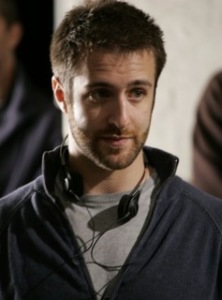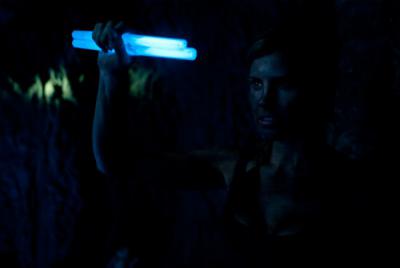By: debbie lynn elias
Coal mining was the bread and butter for much of the Appalachian region of the United States for centuries. Fraught with the inherent dangers of being miles below the earth’s surface in an unknown environment at the mercy of shifting tectonic plates, inhaling dirt and dust with every breath, knowing and fearing that a cave-in could come at any moment, coal mining and mines are almost custom made for the horror genre. Dank, dark and dangerous, the ambient nature alone fuels fear within the recesses of imagination. So it comes as no surprise to find director Ben Ketai taking advantage of those very elements with BENEATH.
Co-written by Patrick Doody and Chris Valenziano, BENEATH is the story of a group of miners trapped beneath the surface when a drilling mis-step causes the mine to collapse on them. With the collapse of the mine, everyone becomes separated and a frightened, ill-equipped and emotionally ill-prepared Samantha Marsh finds herself alone, panicking and frantic to find her father and her ex-boyfriend, Randy, who is also a miner on George’s crew. As everyone reconnects and regroups, strange things start to happen. Sounds, cries, screams are heard coming from tunnels that haven’t been used since a mine collapse over 100 years ago. But then, Sam starts seeing things, horrible things. Scared to death and still panicking, she relays her fears to George, Randy and everyone around, but no one believes her, attributing her claims to hallucinations from impure air. It doesn’t take long, however, for George and Randy to start believing Sam when fellow miners’ bodies start turning up not just dead but grotesquely mutilated. Who, or what, is committing these heinous acts? As each starts to suspect the other, bodies keep dropping, oxygen and phone lines to the surface are cut and hope fades that anyone will get out alive. But as Sam watches her father start suffocating and descend into moments of madness, she determines to find a way out. But how?
In this exclusive interview, I spoke with Ben Ketai about the particulars of making a film like BENEATH, sensitivity to the mining industry and miners, and the importance of his collaborative team in creating a film that is both visually engaging and frightening.

BENEATH is quite an undertaking with this little triumvirate comprised of you, Timothy Burton and the wonderful Toby Wilkins.
Yeah. It is. I love going to work with all those people. It’s really blessed to be able to make a movie with them. It’s not the first time and it won’t be the last.
The first thing that popped into my head when I heard about BENEATH are all of the mining disasters we’ve seen occur all over the world over the past few years. Did you have any trepidation about making this film or any backlash or financing problems because of the base premise?
A little bit. When I came on the project it was pretty late in the process. The film had already been financed and was ready to go. The thought definitely crossed my mind, obviously, because I don’t want to be responsible for upsetting people. At the same time, I feel like it was really an opportunity to tell a great story about great characters and also see a side of the American work force that we don’t actually ever get to see in movies and television. Beyond the genre aspects of [BENEATH], I was fascinated when I read the script. I was fascinated to find the sheer accuracy and getting this glimpse into a world that I knew nothing about before getting involved in the project.
What were some of the biggest challenges and concerns that you and cinematographer Timothy Burton had, in particular with the cinematography, given the low light, the black on black palette?
One of the biggest concerns when Tim and I first sat down to talk about the project was how do we keep this visually interesting for 90 minutes; being in a dark tunnel where the flashlight is scary, but it can wear thin very fast. We set in motion a plan. Tim is an incredibly resourceful cinematographer and incredibly creative. With the desire to do something completely unique and original which we don’t get to see in movies like this, he basically formulated a plan to light the entire film with practical lights. I think 90% of the film is lit with just flashlights, headlamps, and the bare bulbs that you see hanging in the coal mines. It was his prep and his artistry that went into selecting the right bulbs and the right color temperatures and the right flashlights and mixing and matching them in a way that we would never think about while watching the movie but it’s really what makes the movie look as special as it does. I really really give him 100% of the credit for how wonderfully the movie came out as far as the aesthetic. I’m still amazed by what he managed to do with the resources given.
What I appreciate with the lighting palette that you developed is that you have the key blue-light LEDs, fluorescents, shake lights, flashlights, but then you have the old yellow glow of the early 1900’s miner’s lamps. You are really blending history and it just works fabulously.
Thank you. Yeah, the miner’s headlamps were a tricky thing because we wanted to be as accurate as possible but we had to take some creative liberties as in our research we found out they don’t use that anymore. They use LED lights which are much more energy conservative and actually give off a better intensity of light. But the way that they looked on camera did not work for us at all so we had to go out [and find lights that worked correctly]. Our props master scoured the planet [laughing]. She was on eBay a week before we set trying to find all of the authentic old-fashioned miner lights she could because they have specific properties like a golden texture to them. And the way the beam looks and the dust and the smoke is so awesome.

Where did you film BENEATH? Did you build a whole cave-like set or did you actually go to a practical location?
We actually built the entire thing. Every interior you see was shot on a sound stage in Los Angeles. Hats off to our production designer Mike Barton who, with limited resources just like every other department had, managed to build an entire coal mine on a 10,000 square foot soundstage. We basically lived in that space for a month of shooting. The only practical locations we used were the exterior of the mine which wasn’t even a coal mine. It was here in Los Angeles. We found a place out near Santa Clarita called Curtis Sand & Gravel which is a gravel mine and has a lot of similar machinery and a similar aesthetic to the outside of an actual coal mine. They were nice enough to let us use the place. In color timing and post-production we basically changed the colors of the piles of gravel to look like coal.
An interesting aspect of the film is your use of VFX as you move into the horror genre aspect of BENEATH. You could so easily have had the film replete with physical manifestations and morphing that we see dotting the landscape within certain characters. But you chose to prey on the unknown and our inherent fear of darkness as opposed to going for the outright horror tropes. Was that an intentional design, was that something you gave a lot of thought to?
Definitely. I think in any movie like this that relies so heavily on darkness, it’s the viewer’s imagination and thinking about what lies within that darkness that we don’t see that’s so much more terrifying than anything we can ever show you on film. I saw the movie “Alien” when I was probably waaaay too young [laughing] to see a movie like that, but it stuck with me. I remember being amazed at how long it actually takes you to see the monster and that when you do it’s such a terrifying revelation. That notion has stuck with me through everything I’ve done and BENEATH was the best opportunity to try to exercise that restraint.
The restraint worked really well and the fact that the first reveal of the horror is actually in a very unexpected place and time within the story construct was more surprising to me than the revelation itself.
Good! We were excited about seeing the way people reacted in the audience when we first screened it at Screamfest. You definitely don’t see that one coming.
BENEATH is your first feature film. You’ve done television, you’ve directed multiple episodes of “Chosen”, you’ve done some shorts. When you look at the canvas of projects, what do you find is the biggest difference for you as a director helming a feature film as opposed to a tv series?
TV moves much faster and obviously TV is much more a constantly evolving process. The story is being written while you’re working on then show. A feature is so much more contained. There’s such a finite beginning, middle and end. I’ve always admired and desired to work in features more than anything because I love the structure and I love the comaraderie and the family that you build in a specific period of time working with that one crew on that one project. Unfortunately, it’s a craft that’s becoming harder and harder to make happen these days just because of the change in the landscape of the studio system. It’s a really wonderful process.
6/25/14












